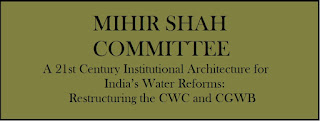MIHIR SHAH COMMITTEE
A high-powered committee led by Mihir Shah was set up to ensure water resource development. The report was titled “A 21st Century Institutional Architecture for India’s Water Reforms: Restructuring the CWC and CGWB”.
Recommendations:
·
It
has suggested that an urgent overhaul of the current water management system is
required Change is required both in surface water as well as ground water
management policies to face the emerging
challenges.
·
It
has suggested a restructuring of Central Water Commission and Central Ground
Water Board.
Ø
At
present, the CWC, which develops surface water projects, and the Central Ground
Water Board (CGWB), which monitors ground water use and contamination, carry
out functions independent of each other.
Ø
For
integrated water management, development, planning, water-use efficiency and
for budgeting the adoption of a river basin approach, restructuring is
necessary.
Ø
The
mandate of CWC belongs to an old era when dam construction and tube well
drilling was the prime need of the hour.
Ø
The
CWC now lacks expertise in water utilisation, environmental and socio-economic
issues and in efficient irrigation management to deal with present-day
challenges of droughts, floods, climate change and food and water security.
·
It
has proposed to establish a National Water Commission (NWC) that will
replace the CWC and the CGWB and become the apex facilitation organisation
dealing with water policy, data and governance. The NWC should be an adjunct
office of the Ministry of Water Resources, functioning with both full autonomy
and requisite accountability.
·
The
key functions of the NWC will include: (i) incentivise state governments
to implement irrigation projects in reform mode, (ii) lead the national aquifer
mapping and ground water management program, (iii) develop a location-specific
program for rejuvenation of rivers, etc.
·
It
has suggested that industrial water should be brought under its ambit, which is
rapidly increasing.
·
It
has warned against the perils of dependence on large dam projects and also
about the dismal spread of irrigation facilities over decades.
·
Tertiary
level canals and below, minor structures and field channels should be handed
over to Water Users Associations of farmers and Integration into the planning
and cost developing process for all irrigation projects.
·
The
key recommendation of the committee is to shift focus from construction to
decentralized management and maintenance.
